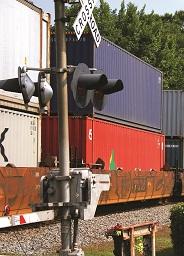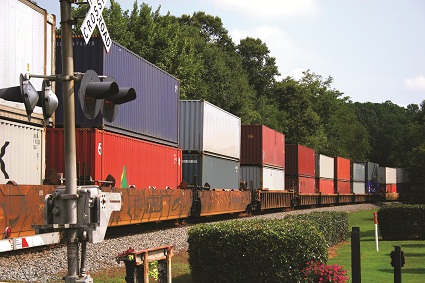
 Freight rail touches nearly every sector of the U.S. economy, moving what consumers want, and businesses and manufacturers need. It is the backbone of the supply chain, bringing U.S. manufactured goods to ports, while along the way nurturing a cascade of American jobs that are supported by the benefits and efficiencies of rail. Without freight rail, businesses would not flourish, and the U.S. economy would be a vastly different landscape with far less economic activity and many fewer jobs.
Freight rail touches nearly every sector of the U.S. economy, moving what consumers want, and businesses and manufacturers need. It is the backbone of the supply chain, bringing U.S. manufactured goods to ports, while along the way nurturing a cascade of American jobs that are supported by the benefits and efficiencies of rail. Without freight rail, businesses would not flourish, and the U.S. economy would be a vastly different landscape with far less economic activity and many fewer jobs.
From steel to housing to agriculture, from manufacturing to small businesses, freight rail is the common thread that allows businesses to succeed. It allows American industries access to regional U.S. and global markets. And it provides American consumers with goods from around the world.
American industries have come to expect myriad benefits of freight rail: the affordability of rail transport, which in turn allows businesses to invest and hire; an inherent fuel efficiency that can move a ton of freight 469 miles on a single gallon of fuel; the ability to relieve highway congestion, with one train carrying the load of 280 or more trucks, and providing the safest way to transport the things we need through the communities railroads serve.
Investing Billions so Taxpayers Don’t Have To
All this economic activity is underpinned by the national treasure that is our country’s privately funded nationwide rail network. With more than 140,000 miles of track, America’s freight railroads privately invest to enhance and maintain America’s world-class rail network. This is in stark contrast to the nation’s highway and waterway systems – which are funded and maintained largely by taxpayers.
Freight railroads shoulder the costs to build, maintain and upgrade the rail lines that stretch from Maine to California. Railroads undertake hundreds of major investment projects each year, spending an average of $20 billion annually in recent years on railroad infrastructure and equipment in the states. Privately owned railroads have spent more than $500 billion since 1980 on the country’s nationwide rail network, the equivalent of 42 cents of every revenue dollar.
In 2012 alone, the private investment is expected to tally an estimated $23 billion, and investment in infrastructure and equipment stimulates the economy through job creation and enhanced mobility.
Investments by rail companies have a multiplier effect. The economic value of freight rail can be seen in many direct forms, as freight railroads generate $265 billion in total annual U.S. economic activity and move one-third of American exports. The industry employs more than 175,000 workers in high-paying jobs—with average annual wages and benefits topping $103,000 – each of which supports another 4.5 jobs across the country. Overall, rail supports more than 1 million jobs across the broad U.S. economy in fields such as manufacturing and retail.
Freight Rail Bringing Economic Benefits to Communities
Behind the statistics are compelling local stories about how rail supports regional economic activity. Businesses large and small, established and new, rely on freight rail to deliver their goods to market, and in turn these businesses support and create other businesses and jobs in their local community.
Caterpillar began operations in 1909 as Holt Manufacturing with just 12 employees in East Peoria, Illinois. The business thrived – and one of the reasons it continues to thrive is that it has direct access to rail lines and thus can ship fully assembled tractors to customers across the country and to ports with ease. The company today employs 16,000 people in the Peoria area and 90,000 worldwide.
In Jefferson County, Alabama, freight rail is helping rebuild the local economy. Spurred by the rebounding freight rail industry and expected growth in freight rail volume, Amsted Rail, a major supplier to the railroads for more than a century, recently opened the doors on its renovated Griffin Wheel plant, creating more than 130 high-skilled manufacturing jobs in Jefferson County. In addition to the cost advantages, company officials like being near their customer base and recognize the value of being located along the supply chain.
Hiring Veterans for the Country’s Best Workforce
Contributing to freight rail’s success are the men and women freight railroads hire, many of whom are U.S. veterans. In fact, the nation’s freight railroads have a century-long commitment to the men and women who have served in the armed forces. Today, roughly 25 percent of the railroad workforce is veterans. And at least 5,000 of the more than 15,000 new employees freight railroads forecasted to hire in 2012 likely are veterans.
The skills and traits that make someone a successful service member are coveted by the railroads. Our nation’s veterans have a disciplined background, with special capabilities and qualities that are uniquely suited to help keep freight railroads efficient and safe.
We’re proud to be able to offer military men and women not just jobs, but true careers in jobs that are a great fit with the skills they’ve acquired while serving our country. Veterans are unequaled examples of commitment, reliability and leadership.
President Theodore Roosevelt said that “far and away the best prize that life offers is the chance to work hard at work worth doing.” We want to provide that opportunity for our veterans.
As the nation struggles to rebound from the recent recession, maintaining a healthy freight rail industry will be an essential driver of that recovery.

